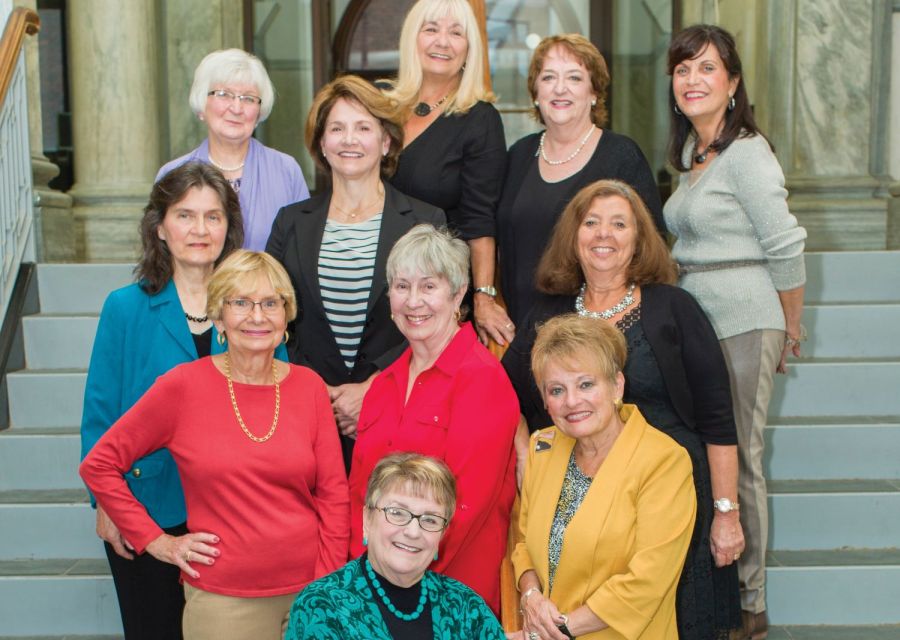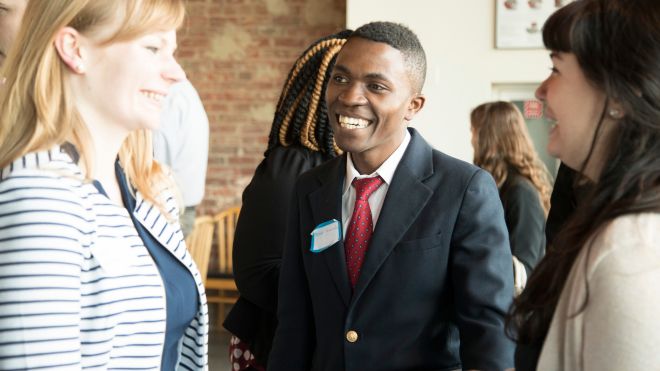
BUFFALO, NY - Barbara (Kiedrowski) Shuckra ’63 didn’t intend to be a trailblazer. She simply wanted to earn an accounting degree from Canisius and pursue a career with the Internal Revenue Service.
Instead, Shuckra and seven other like-minded young women were part of a bold social experiment on campus in 1961: They became the first female students to enroll in the day division at Canisius.
“I was in my sophomore year at Rosary Hill College (now Daemen College) when a nun told me the school was closing its accounting program,” recalls Shuckra. “That same day, my mother read in The Buffalo Evening News that Canisius was opening up the business school’s day division to women. Go figure! I transferred to Canisius the following year.”
The First Ones
Shuckra and her counterparts weren’t the first female students to set foot on Canisius’ campus. Around the college’s half-century mark, in 1920, Canisius began to admit women – on a limited basis – to undergraduate and graduate evening courses in teacher education and business. The college opened its doors a bit wider to women in 1941 with the launch of a pre-clinical nursing program offered in conjunction with Sisters and Mercy hospitals. The nurses attended classes in the evening. However, when World War II took a toll on traditional enrollment, Canisius allowed the nurses to attend some day classes.
More women matriculated to Canisius’ evening programs over the next 10-plus years, slowly chipping away at Canisius’ all-male atmosphere. Still, those women remained in a class all their own.
“At this time in history, if you were not a full-time day student, you were not considered part of the student body,” explains Canisius Archivist Kathleen M. Delaney ’73. “Women could not participate in the same social clubs as men. They had to form their own. They weren’t even photographed for the yearbooks.”
While murmurings of support for the admission of women into the day division gradually grew louder, Canisius didn’t get serious about coeducation until spring 1960.
A Call for Change
In a letter to the New York provincial for the Society of Jesus, Canisius President Rev. James J. McGinley HON '60, SJ, requested the leader’s “earnest consideration that School of Business Administration (SBA) become coeducational.” Father McGinley cited a heightened demand among women who wanted to pursue careers in various aspects of marketing and management. He emphasized that “Canisius offers Buffalo’s only collegiate program in business administration, under the Catholic auspices.” Father McGinley concluded: “Traditional objections to coeducation ought not to hold for the SBA which is, in nature, a semi-professional institution.”
Approval for Father McGinley’s request came swiftly. In September 1961, the college admitted eight women (six freshmen and two junior transfer students) into the full-time day division of the School of Business Administration, making them bona-fide Canisius students.
“It was certainly intimidating, walking onto campus for the first time,” says Joyce A. (Lauchert) Meegan ’65. “There was no way I could go there by myself, so I randomly called a few of the other coeds, whose names were published in the newspaper, to see if we could meet before class and walk in that first day together.”
Soon after the School of Business Administration admitted women to its day division, pressure began to build for Canisius to become a full coeducational college. Appeals came from parents and guidance counselors in public and private schools. Canisius faculty members, both lay and Jesuit, signed a petition calling upon the college to “hasten the time of women’s entry.” A majority of alumni voiced their support. And, the male student body supported the admission of women into the classrooms.
“It made no sense to limit the women to just one school,” says James P. Hagan ’66, former president of the undergraduate student association. “If Canisius was going to allow women to come to the college, then they should be able to pursue degrees in whatever programs Canisius offered, not just those in the School of Business.”
The Board of Trustees responded to the appeals. In September 1965 – 50 years ago this fall – Canisius opened its doors to women in all academic day divisions.
The decision definitely had financial advantages. Census figures predicted a vast increase in the number of high school graduates – male and female – through 1980. New and added tuition revenue meant Canisius could better maintain its “costly physical plant” and secure “the college’s survival,” wrote former SBA Dean James L. McCarthy, PhD, in a memo to Father McGinley.
Yet, archival notes overwhelmingly show that the primary impetus for change was educational, not financial.
By widening the pool of applicants, Canisius could be more selective in admitting students, thereby “improving upon its high quality student body,” continued McCarthy. As more professional opportunities opened up for women, it became increasingly necessary “that they be educated along with the men with whom they will be working,” added former Dean of Men Donald A. Nair, PhD.
In his report to the Board of Trustees, Father McGinley said the college “had an obligation to the community” to provide a parochial, coeducational program. “There are fine girls from fine Catholic families who do not wish to continue their educations at colleges conducted by women religious … or at tax-supported institutions.”
Denise O’Donnell ’68 was among them.
She came to Canisius from Mount St. Joseph’s High School, an all-girls institution just across the street from campus.
“I was definitely interested in moving to a coed environment,” she says. “Back then, more women wanted a college education to move ahead professionally so it made sense to want to go to school with men. We were already together in society.”
O’Donnell chose Canisius because of its “reputation for educating leaders in the Jesuit tradition.” Other women selected the college for its small class sizes. Still more came at the encouragement of fathers, brothers and uncles, many of whom were Canisius alumni.
“My brother (Kenneth V. Klementowski ‘62) kept bragging about Canisius and the education he received so what else could I do but go here,” laughs Diane L. (Klementowski) Sandler ’65.
The Female Effect
Aside from typical freshmen jitters, fear of being ignored, teased or discriminated against compounded the anxieties of the female students. Shuckra recalls with a laugh, “I never sat in the first row in any of my classes; always in an aisle seat in case I wanted to escape!”
It turned out the women’s fears were largely unfounded.
“The men on campus generally had three points of view,” recalls Dorothy (Logal) Gaglione ’65. “Some were extremely helpful; others not so much. Most men however, seemed to fall in between the two – they were cautiously intrigued by the women.”
O’Donnell adds, “Every so often an old-guard male faculty member might crack a joke at our expense, but the male students I met were all very accepting of the women and, I think, appreciated and respected the diversity and perspective we brought to the classroom.”
In fact, the women shined in the classroom.
“These women were not about to take a back seat to anyone in the classroom,” says Walter G. Sharrow HON ’13, PhD. “They demolished the old boys’ network. The women were the new people in town and they weren’t taking any prisoners.”
They amassed scholarships and received national recognition for academic achievements. The women represented Canisius internationally, as well. Three early female students were accepted to foreign study programs and spent their junior years at institutions in Louvain, Belgium and Heidelberg, Germany.
“The educational environment at Canisius was wonderful for me,” says Marta (Morozewych) Laux ’69. “Being able to exchange thoughts, ideas and opinions with the men in my classes – who very often came at things from a different perspective – encouraged me to think and reason anew. That’s stayed with me throughout my life.”
It wasn’t long before Canisius altered its course offerings to be more reflective of the female student body. New classes included women in literature, the feminine role of religion, psychological perspectives on women and the future of marriage. Today, Canisius offers a minor program in women and gender studies.
“Having women on campus added immeasurably to the tone and the atmosphere of the college,” recalls Kenneth M. Sroka ’65, PhD, emeritus professor of English. “They were a catalyst for improving not only the intellectual life of the campus but the cultural and social life that was Canisius, as well.”
The women lost no time contributing to the life of the college. They organized Initiae, a club that “brought together the new girls of Canisius as a way for them to bond and help one another out,” says first-year president Diane Sandler. The women later launched the Canisius chapter of Phi Gamma Nu, a national business honor society for female students.
“We didn’t do it by ourselves,” recalls Alfrieda M. (Haas) Sutz ’65. “We had the tremendous support of Lillian Levey ‘57, MS ’67, HON ’03.” The late dean of women “was determined to make female students an important part of Canisius. She was a powerhouse of a woman and extremely active in getting us involved.”
The men did invite women to become part of campus life. Leaders from the rifle team, glee club and cheerleading squad all encouraged women to join the traditional all-male clubs.
By 1972, Canisius had its first female president of the Undergraduate Student Association, Barbara J. (Haefner) Heim ‘74. Shelley (Francolini) Maher ‘73 became the first female president of the Student Union Board. Both the Azuwur and THe Griffin had their first female editors that same year: Eileen (Duch) Rolek ’73, MS ’77 and Ann E. (Schott) Burke ’73, respectively.
That same year, women’s equality took its greatest leap forward at Canisius and across the country. Congress passed Title IX of the Education Amendments Act. Though it’s most often associated with athletics, Title IX prohibits sex discrimination in any educational program or activity at all institutions that receive federal funds.
“It was landmark legislation that lit a fire under the progress of women at Canisius and educational institutions everywhere,” recalls Ellen O. Conley, PhD. The former vice president for student affairs was one of the few female educators at Canisius in the 1970s.
Today, it’s hard to imagine a time when women weren’t an integral part of campus. More than a half century later, female students make up 54 percent of Canisius’ full-time undergraduate student population. Nearly half of the full-time faculty members are women. For the first time in Canisius history, women hold the majority of the college’s five senior leadership positions.
The strength of Canisius women is sure to grow and endure with the recent formation of the Women’s Leadership Council (WLC). Comprised of distinguished and influential women – many of them Canisius alumnae - the WLC engages female students, faculty, alumni and friends of the college to prepare for leadership roles in their chosen fields and in the community.
And to think, it all started with a small group of determined women who had the guts and grace to blaze a trail at 2001 Main Street.
“When I was in college, female role models were few and far between,” says O’Donnell, a presidentially-appointed Department of Justice official in Washington, DC. “There weren’t many women lawyers, doctors or judges but the world is always improved by diversity. To its credit, Canisius recognized this and taught me that I can compete on a level playing field.”
“I don’t think of myself as a pioneer. I just wanted to learn and get a good education,” adds Logal. “Although looking back now, I wonder where I found the guts to do it. I really do.”



